 W
WThe Amazon dwarf squirrel is a chipmunk-sized tree squirrel native to South America.
 W
WThe Andean squirrel is a tree squirrel endemic to Colombia where it inhabits montane rain forest and cloud forests of the Cordillera Occidental and Cordillera Central ranges of the Colombian Andes, at elevations between 2,000 and 3,300 metres. It is a small species with a body length of about 14 cm (6 in) and a similar length tail. It has soft, silky, reddish-brown fur, a darker tail and yellowish-grey underparts. It is thought to be diurnal but has been little studied, and the International Union for Conservation of Nature has rated its conservation status as being data deficient.
 W
WThe Antarctic minke whale or southern minke whale is a species of minke whale within the suborder of baleen whales. It is the second smallest rorqual after the common minke whale and the third smallest baleen whale. Although first scientifically described in the mid-19th century, it was not recognized as a distinct species until the 1990s. Once ignored by the whaling industry due to its small size and low oil yield, the Antarctic minke was able to avoid the fate of other baleen whales and maintained a large population into the 21st century, numbering in the hundreds of thousands. Surviving to become the most abundant baleen whale in the world, it is now one of the mainstays of the industry alongside its cosmopolitan counterpart the common minke. It is primarily restricted to the Southern Hemisphere and feeds mainly on euphausiids.
 W
WThe Aru flying fox is a Critically Endangered species of megabat found in the Aru Islands in Indonesia. It was described by Wilhelm Peters in 1867. It was formerly considered a subspecies of the black-bearded flying fox. The species is poorly known, and has not been encountered since the 19th century. It is classified as critically endangered by the IUCN and is listed on CITES appendix II.
 W
WThe big-eared flying fox is a species of bat in the family Pteropodidae, larger bats who subsist largely on fruits. The species is distributed across a range in Indonesia, Papua New Guinea and islands nearing the Cape York peninsula at the northeast of Australia, at elevations less than 500 metres and often in coastal mangroves.
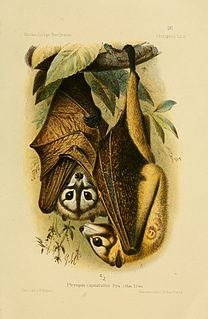 W
WThe Bismarck masked flying fox is a species of flying fox in the family Pteropodidae found in Papua New Guinea and named after the Bismarck Archipelago. It was once considered a subspecies of Pteropus temminckii before being reassessed in 2001. This species has two subspecies, P. c. capistratus and P. c. ennisae. The IUCN classified it as Near Threatened in 2009, noting that the rate of decline is almost high enough to reclassify the species as Vulnerable.
 W
WThe black-bearded flying fox is an endangered species of megabat in the genus Pteropus. It is endemic to Indonesia, found on the islands of Ambon, Buru, Seram, Banda, and Yamdena. Currently considered monotypic, it formerly included the Aru flying fox and Kei flying fox as subspecies.
 W
WThe blue-eyed black lemur, also known as the Sclater's lemur, is a species of true lemur. It can attain a body length of 39–45 cm, a tail length of 51–65 cm- a total length of 90–100 cm, and a weight of 1.8-1.9 kg. Being a primate, it has strong hands with palms like a human, which have a rubbery texture to give it a firm grip on branches. Its tail is longer than its body and is non-prehensile.
 W
WThe Bolivian squirrel is a tree squirrel that is endemic to South America. Little is known of the species, which may represent a species complex.
 W
WThe Cambodian striped squirrel is a species of rodent in the family Sciuridae. It is found in eastern Thailand, Cambodia, southern Laos, and southern Vietnam.
 W
WThe Celebes rat is a species of rodent in the family Muridae. It is found only in Sulawesi, Indonesia.
 W
WThe Ceram fruit bat or Seram flying fox is a species of megabat in the family Pteropodidae. It is endemic to the mountainous forests of two Indonesian islands, Buru and Seram, including the Manusela National Park on Seram. They were once present on the nearby Ambon Island, but probably not anymore. The habitat has an area of less than 20,000 km2, and is decreasing due to logging. For this reason, and because of hunting by the local population, these species are listed as vulnerable by the IUCN since 1996.
 W
WThe Chinese hamster is a rodent in the genus Cricetulus of the subfamily Cricetidae that originated in the deserts of northern China and Mongolia. They are distinguished by an uncommonly long tail in comparison to other hamsters, most of whose tails are stubby. Chinese hamsters are primarily nocturnal, however they will stay awake for brief periods, in between naps, throughout the day.
 W
WThe Chinese zokor is a species of rodent in the family Spalacidae. It is endemic to China, ranging from Qinghai Province eastwards to Beijing in steppe and alpine grasslands. Henri Milne-Edwards first described it in 1867. Eradication programs in the 1990s in Qinghai Province resulted in a population decline to less than a third of the former population. It is considered common and has been assessed as Least Concern by IUCN.
 W
WThe common blossom bat also known as the southern blossom bat or Queensland blossom bat, is a megabat in the family Pteropodidae. The common blossom bat feeds mostly on nectar and pollen rather than fruit. It is one of eight Pteropodidae species on mainland Australia. It is one of the smallest of all nectarivorous megabats.
 W
WCoquerel's giant mouse lemur, also known as Coquerel's dwarf lemur or the southern giant mouse lemur, is a small nocturnal lemur endemic to Madagascar. This species can be found in parts of the Madagascar dry deciduous forests.
 W
WCoquerel's sifaka is a diurnal, medium-sized lemur of the sifaka genus Propithecus. It is native to northwest Madagascar. Coquerel's sifaka was once considered to be a subspecies of Verreaux's sifaka, but was eventually granted full species level, and is listed as endangered due to habitat loss and hunting. In popular culture, it is known for being the species of the title character in the children's TV show Zoboomafoo.
 W
WThe crest-tailed mulgara, is a small to medium-sized Australian carnivorous marsupial and a member of the family Dasyuridae which includes quolls, dunnarts, the numbat, Tasmanian devil and extinct thylacine. The crest-tailed mulgara is among a group of native predatory mammals or mesopredators endemic to arid Australia.
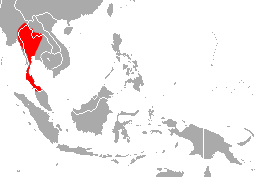 W
WThe croslet horseshoe bat is a species of bat in the family Rhinolophidae. It is found in Laos, Malaysia, Myanmar, and Thailand.
 W
WDecken's horseshoe bat is a species of horseshoe bat. It is found in Kenya and Tanzania. Its natural habitats are subtropical or tropical moist lowland forest, subtropical or tropical moist montane forest, moist savanna, caves, and subterranean habitats. It is threatened by habitat loss.
 W
WThe giant white-tailed rat is an Australian rodent native to tropical rainforest of north Queensland, with subspecies occurring in New Guinea and the Aru Islands. It is one of the largest rodents in Australia, reaching up to 1 kg in weight, is grey-brown above, cream to white below, and has a long, naked tail of which the distal section is white.
 W
WThe gray sac-winged bat is a species in the family Emballonuridae which comprises the 51 species of sac-winged bats. It is found in Mexico from Baja California Sur and Sonora to Guatemala, El Salvador, Honduras, Nicaragua, Costa Rica and northern Colombia, at elevations up to 1,500 metres (4,900 ft).
 W
WThe greater dog-like bat is a bat species from Central America and South America. It is found from southern Mexico through Brazil and Peru.
 W
WThe groove-toothed flying squirrel or North Chinese flying squirrel is a species of rodent in the family Sciuridae. It is monotypic within the genus Aeretes. It is endemic to China, and occurs in Sichuan, Gansu, Hebei, and Beijing. Its natural habitat is temperate forests.
 W
WThe Indian desert jird or Indian desert gerbil is a species of jird found mainly in the Thar Desert in India. Jirds are closely related to gerbils.
 W
WThe inornate squirrel is a species of rodent in the family Sciuridae. It is found in China, Laos, and Vietnam.
 W
WThe Kei flying fox is a species of megabat in the genus Pteropus found in the Kai Islands of Indonesia. It was formerly considered a subspecies of the black-bearded flying fox. Very little is known about the species, its habitat, or threats to it.
 W
WLeadbeater's possum is a critically endangered possum largely restricted to small pockets of alpine ash, mountain ash, and snow gum forests in the Central Highlands of Victoria, Australia, north-east of Melbourne. It is primitive, relict, and non-gliding, and, as the only species in the petaurid genus Gymnobelideus, represents an ancestral form. Formerly, Leadbeater's possums were moderately common within the very small areas they inhabited; their requirement for year-round food supplies and tree-holes to take refuge in during the day restricts them to mixed-age wet sclerophyll forest with a dense mid-story of Acacia. The species was named in 1867 after John Leadbeater, the then taxidermist at the Museum Victoria. They also go by the common name of fairy possum. On 2 March 1971, the State of Victoria made the Leadbeater's possum its faunal emblem.
 W
WThe long-eared chipmunk, also called the Sacramento chipmunk or the four-banded chipmunk, is a species of rodent in the squirrel family, Sciuridae. It is endemic to the central and northern Sierra Nevada of California and Nevada in the United States. Long-eared chipmunks have the longest ears of all species of chipmunks.
 W
WThe long-tailed goral or Amur goral is a species of ungulate of the family Bovidae found in the mountains of eastern and northern Asia, including Russia, China, and Korea. A population of this species exists in the Korean Demilitarized Zone, near the tracks of the Donghae Bukbu Line. The species is classified as endangered in South Korea, with an estimated population less than 250. It has been designated South Korean natural monument 217. In 2003, the species was reported as being present in Arunachal Pradesh, in northeast India.
 W
WThe maned rat or crested rat is a nocturnal, long-haired and bushy-tailed East African rodent that superficially resembles a porcupine.
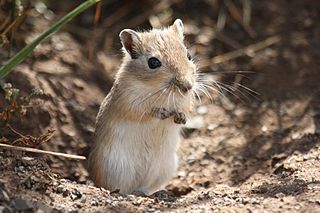 W
WThe Mongolian gerbil or Mongolian jird is a small rodent belonging to the subfamily Gerbillinae. Body size is typically 110–135mm, with a 95–120mm tail, and body weight 60–130g, with adult males larger than females. The animal is used in science and kept as a small house pet. Their use in science dates back to the latter half of the 19th century, but they only started to be kept as pets after 1954, when they were brought to the United States. However, their use in scientific research has fallen out of favor.
 W
WThe montane guinea pig is a species of caviid rodent found in the Andes in South America. The montane guinea pig is the likely ancestor of Cavia porcellus, the domestic cavy or domestic guinea pig.
 W
WThe montane myotis is a species of vesper bat. It is found in Bolivia, Colombia, Costa Rica, Ecuador, Panama, Peru, and Venezuela.
 W
WThe narrow-striped mongoose is a member of the family Eupleridae endemic to Madagascar. It inhabits the Madagascar dry deciduous forests in western and southwestern Madagascar, where it lives from sea level to about 125 m (410 ft) between the Tsiribihina and Mangoky rivers. In Malagasy it is called bokiboky.
 W
WNilgiri vandeleuria, also known as the Nilgiri long-tailed tree mouse and the Indian long-tailed tree mouse, is a species of rodent in the family Muridae. There has been some dispute as to whether this specimen is actually a subspecies of the Asiatic long-tailed climbing mouse but current opinion seems to suggest that it is indeed a separate species. It is found in India.
 W
WThe North African boar is a smaller subspecies of wild boar native to North Africa including Morocco, Algeria and Tunisia. It is a prey animal for predators such as striped hyenas, African leopards and Barbary lions.
 W
WThe North African gerbil is a species of rodent in the family Muridae. It is found in North Africa where its natural habitats are arable land and rocky areas of the Maghreb, and hot Saharan deserts.
 W
WThe Northern Sulawesi echiothrix or Sulawesi spiny rat is a species of rodent in the family Muridae. It is endemic to northeastern Sulawesi, Indonesia.
 W
WPallas's pika, also known as the Mongolian pika, is a species of small mammals in the pika family, Ochotonidae. It is found mainly in the mountains of western Mongolia.
 W
WThe Père David's rock squirrel, also known as the Chinese rock squirrel, is a species of rodent in the family Sciuridae. It is endemic to China, where it is found widely in rocky habitats in the eastern and central parts of the country. This largely terrestrial squirrel is overall dull olive-grey with paler underparts, a distinct pale eye-ring and a dark patch on the cheeks. It has sometimes been confused with the rather different –but in colour very variable– Pallas's squirrel; an introduced population in Belgium was first mistakenly identified as Père David's rock squirrel.
 W
WPerny's long-nosed squirrel is a species of rodent in the family Sciuridae. It is found in Northeast India, southern and central China, northern Myanmar, northern Vietnam, and Taiwan.
 W
WPeters's dwarf epauletted fruit bat is a species of megabat in the family Pteropodidae. It is found in Angola, Benin, Burkina Faso, Burundi, Cameroon, Central African Republic, Chad, Republic of the Congo, Democratic Republic of the Congo, Ivory Coast, Equatorial Guinea, Ethiopia, Gabon, Gambia, Ghana, Guinea, Guinea-Bissau, Kenya, Liberia, Mali, Niger, Nigeria, Rwanda, Senegal, Sierra Leone, Sudan, Tanzania, Togo, Uganda, and Zambia. Its natural habitats are subtropical or tropical moist lowland forests and moist savanna.
 W
WThe red-tailed sportive lemur, or red-tailed weasel lemur, is native to Madagascar like all lemurs. It is a nocturnal species feeding largely on leaves, though they also eat some fruit. Individuals weigh around 800 g (1.8 lb), and there is little sexual dimorphism. In general they live in mated pairs, with a home range of about 10,000 square metres. Both members of the pair use the same home range, and there is little overlap between the home ranges of neighbouring pairs. Travel distances each night are between 100 m (330 ft) and 1 km (0.6 mi), making this a relatively inactive species. This species can be found in the Madagascar dry deciduous forests.
 W
WThe short-faced mole is a species of mammal in the family Talpidae. It is monotypic within the genus Scaptochirus. It is endemic to China.
 W
WThe Arizona gray squirrel is a tree squirrel, in the genus Sciurus, endemic to the canyons and valleys surrounded by deciduous and mixed forests in eastern Arizona and northern Mexico.
 W
WThe Sulawesi flying fox or Sulawesi fruit bat is a species of megabat endemic to Indonesia. It is classified as "Vulnerable" by the IUCN due to unsustainable levels of hunting.
 W
WTemminck's flying fox is a species of flying fox in the family Pteropodidae. It is found in Indonesia. The species was classified as "Vulnerable" in 2008 by the IUCN due to threats from habitat destruction and hunting.
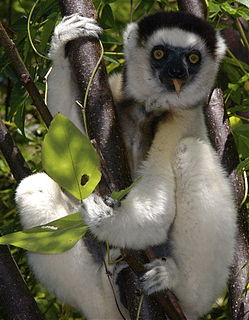 W
WVerreaux's sifaka, or the white sifaka, is a medium-sized primate in one of the lemur families, the Indriidae. It lives in Madagascar and can be found in a variety of habitats from rainforest to western Madagascar dry deciduous forests and dry and spiny forests. Its fur is thick and silky and generally white with brown on the sides, top of the head, and on the arms. Like all sifakas, it has a long tail that it uses as a balance when leaping from tree to tree. However, its body is so highly adapted to an arboreal existence, on the ground its only means of locomotion is hopping. The species lives in small troops which forage for food.
 W
WVon der Decken's sifaka is a sifaka endemic to Madagascar. It has a length of 92 to 107 centimeters, of which 42-48 centimeters are tail. Von der Decken's Sifaka lives in western Madagascar. It lives in dry deciduous forest.
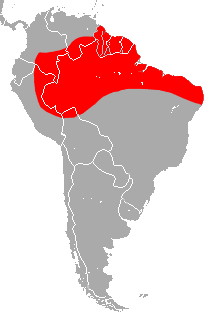 W
WThe white-winged dog-like bat is a bat species from South America. It is found in northern Brazil, southeastern Colombia, Ecuador, French Guiana, Guyana, eastern Peru, Surinam and Venezuela.
 W
WThe yellow-bellied sheath-tailed bat, also known as the yellow-bellied sheathtail or yellow-bellied pouched bat, is a microbat species of the family Emballonuridae found extensively in Australia and less commonly in parts of Papua New Guinea.
 W
WThe yellow-tailed rat is a species of rodent in the family Muridae. It is found only in northeastern Sulawesi, Indonesia.